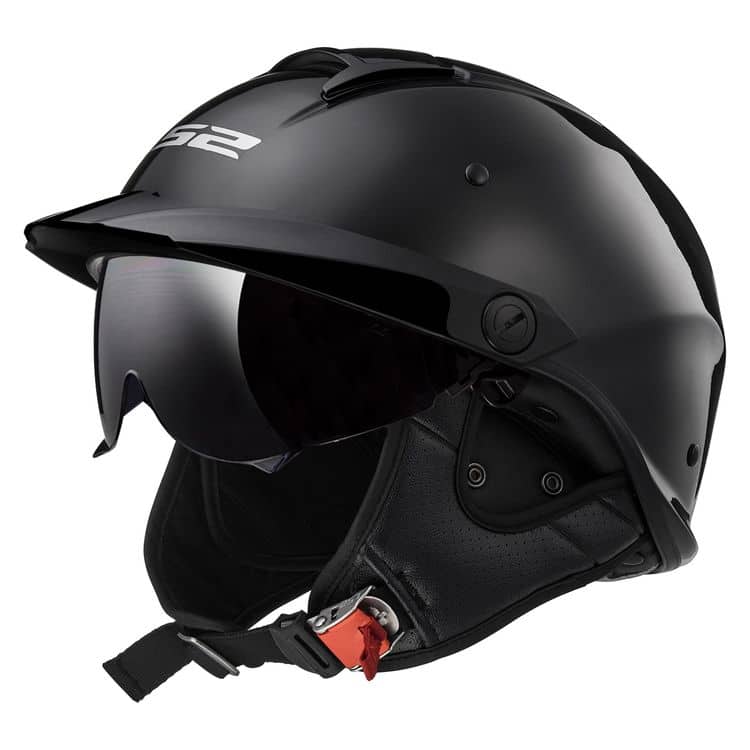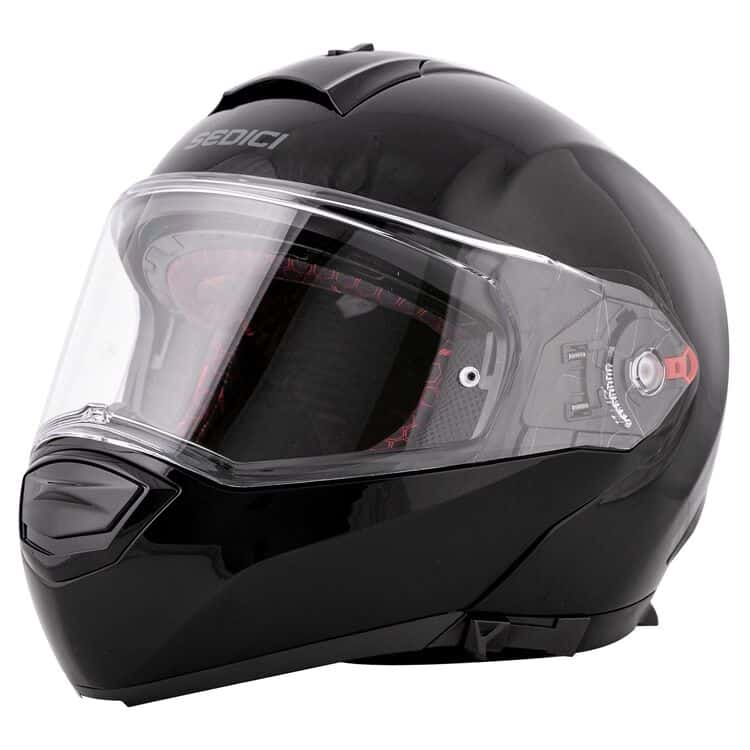When it comes to motorcycle safety gear, there’s no doubt that the helmet stands out as the most essential item. However, it’s important to recognize that not all helmets are alike, and most riders find id it challenging to choose the ideal helmet for them.
On one hand, prioritizing safety is of utmost importance, on the other hand, some riders prefer to have unrestricted freedom and comfort during their rides.
What is The Least Restrictive Helmet?
Open-face or half-face helmets are the least restrictive because they leave the face exposed and offer more visibility and airflow, making them comfortable for riders. However, they provide overall less protection compared to other helmet types, making them unsuitable for dangerous riding conditions.
Keep on reading as we break down the differences between each type of motorcycle helmet and determine which of them is the least restrictive.
Are There Different Types of Helmets?
There are several types of motorcycle helmets, each designed with specific features and purposes in mind.
So, let’s check out the differences between each type:
1. Full-Face Helmet
This type provides the most comprehensive protection. They cover the entire head and face, including the chin and jaw. They have a clear face shield that can be opened and closed, offering protection from wind, debris, and insects.
-
- Advantages: Provides excellent impact protection and enhanced aerodynamics.
- Disadvantages: Can feel hot and claustrophobic and may restrict peripheral vision.
2. Open-Face Helmet (3/4 Helmet)
Open-face helmets cover the top and sides of the head but leave the face exposed. Some have optional face shields or goggles for eye protection. They are popular among cruiser and scooter riders, providing a more open feel while still offering protection.
-
- Advantages: Provides more comfort.
- Disadvantages: Offers less protection to the face and chin, making riders vulnerable in case of a crash.
My Top Recommended Helmet Picks — CLICK HERE! I highly recommend these motorcycle helmets for their affordable yet top-notch quality, reflecting my extensive 50+ years of motorcycling experience and expertise as a rider, leader, and consultant in 25+ countries. So, whether you're a seasoned rider seeking an upgrade or a new enthusiast starting your journey on two wheels, I'm confident that these gear recommendations will serve you exceptionally well. |
|---|
3. Half-Face Helmet
Half-helmets cover only the top of the head, leaving the face and ears exposed. They are lightweight and offer the least protection compared to other helmet types.
-
- Advantages: Lightweight and minimalistic design, ideal for short trips and warm weather.
- Disadvantages: Offers the least protection.
4. Modular Helmet (Flip-up)
Modular helmets combine features of both full-face and open-face helmets. They have a hinged chin bar that can be lifted, allowing riders to easily switch between full-face and open-face configurations, which is convenient when you need to communicate or take a quick break without removing the helmet entirely.
-
- Advantages: Allows for switching between different configurations
- Disadvantages: Slightly heavier and more complex than traditional full-face helmets, potentially less sturdy at the hinge.
5. Off-Road (Motocross) Helmet
Off-road helmets are designed for dirt biking, motocross, and other off-road riding activities. They have a distinctive design with a large visor and a chin guard. These helmets are lightweight, provide good ventilation, and have a unique shape to accommodate goggles.
-
- Advantages: Enhanced chin and visor protection, excellent ventilation, and goggles compatibility.
- Disadvantages: Bulky and less suitable for on-road use due to limited noise reduction and aerodynamics.
6. Dual-Sport Helmet
This type is versatile and suitable for both on-road and off-road riding. They resemble a combination of full-face and off-road helmets, with a large visor, good ventilation, and an extended chin bar.
-
- Advantages: Blends the features of off-road and full-face helmets, suitable for adventurous riders.
- Disadvantages: May not excel in either category when compared to specialized helmets.
What Is the Least Restrictive Helmet?
The least restrictive type of motorcycle helmet is the open-face or half-face helmet.
As mentioned earlier, these two types of helmets offer more freedom and comfort to the rider compared to full-face helmets because they leave the face exposed and allow more airflow as well as visibility.
However, they provide less overall protection, especially to the face and chin, making them suitable primarily for shorter rides and urban commuting where lower speeds are typical.
The Top Picks for the Least Restrictive Helmets
My top pick for the least restrictive helmet is this open-face HJC CS-5N helmet. It combines safety, comfort, and affordability into one exceptional package.

The HJC CS-5N boasts exceptional build quality and meets DOT safety standards, providing the kind of confidence you want in a helmet.
When it comes to comfort, this helmet is impressively lightweight, which greatly reduces neck fatigue on long rides, and its interior padding is plush and conforms nicely to the shape of your head. It’s also removable and washable, which is a huge plus for keeping your helmet fresh and clean after long rides.
Despite its high-quality features, the CS-5N is surprisingly affordable, so you get a premium helmet without breaking the bank.
Now if you prefer to go for an even less restrictive helmet, I recommend this half-face Bell Pit Boss helmet which offers an exceptional level of comfort thanks to its innovative Speed Dial adjustable fit system that allows for a snug and secure feel on your head.

The Pit Boss doesn’t compromise when it comes to safety, as it still meets DOT safety standards and offers excellent coverage for your head. It also features a removable neck curtain that provides extra protection from the elements and can be removed on hot days, making it suitable for various weather conditions.
How Do You Stay Safe in a Half-Face or Open-Face Helmet?
Ensuring your safety while wearing a half-face or open-face helmet requires some additional precautions due to the reduced coverage compared to full-face helmets.
So, here are some tips to maximize safety when using this type of helmet:
- Choose Quality Helmets: Invest in a high-quality, DOT or ECE-certified half-face or open-face helmet. Look for reputable brands that prioritize safety in their designs.
- Proper Fit: Ensure a snug and secure fit by selecting the right helmet size. It should sit firmly on your head without being too tight or too loose. Follow the manufacturer’s sizing guidelines.
- Face Shield or Goggles: Wear a protective face shield or goggles to shield your eyes from wind, debris, and insects. This is especially important as your face is exposed.
- Chin Strap Securement: Fasten the helmet’s chin strap securely and snugly under your chin. Make sure it is adjusted to prevent the helmet from shifting during a ride.
- Additional Gear: Wear additional protective gear like a full-face balaclava or neck gaiter to cover your face and neck. This provides added protection from wind, dust, and sunburn.
- Dress Appropriately: Choose appropriate riding gear, including a jacket, gloves, pants, and sturdy footwear, to protect your body in case of a fall.
- Mind the Speed: Be mindful of your riding speed. Avoid high-speed or long-distance trips where greater protection may be needed.
- Safety First: Always prioritize safety. Avoid reckless riding behaviors, obey traffic laws, and be cautious when maneuvering through traffic.
- Stay Alert: Maintain heightened awareness while riding, as your face is exposed to various elements. Be prepared to react quickly to potential hazards.
- Regular Inspections: Routinely inspect your helmet for signs of wear and tear. Replace it if you notice any damage or if it has been involved in a crash.
Conclusion
In the quest for the perfect motorcycle helmet that offers both safety and freedom of movement, riders have various options to consider. While half-face or open-face helmets offer more comfort and visibility, they do provide less overall protection.
Overall, it’s essential to strike a balance between comfort and safety based on your riding style and the conditions you’ll encounter on the road. So, whichever helmet you choose, make sure it meets safety standards and provides a comfortable fit for an enjoyable and secure ride.
 I've diligently categorized my motorcycle gear recommendations into all available categories, with the aim of providing you with a comprehensive analysis that showcases the absolute best options for all your needs. These items are the culmination of in-depth research, extensive testing, and personal use throughout my vast experience of 50+ years in the world of motorcycling. Besides being a passionate rider, I've held leadership positions and offered consultancy services to reputable companies in over 25 countries worldwide. To See Our Top Picks and the Best Prices & Places to Buy: Click Here! |
Information for this article was partially sourced and researched from the following authoritative government, educational, and non-profit organizations:
- National Institute of Health
- Smarter USA
- United States Department of Transportation (DOT)
- United States Economic Commission of Europe (ECE)
Ni/Ni







